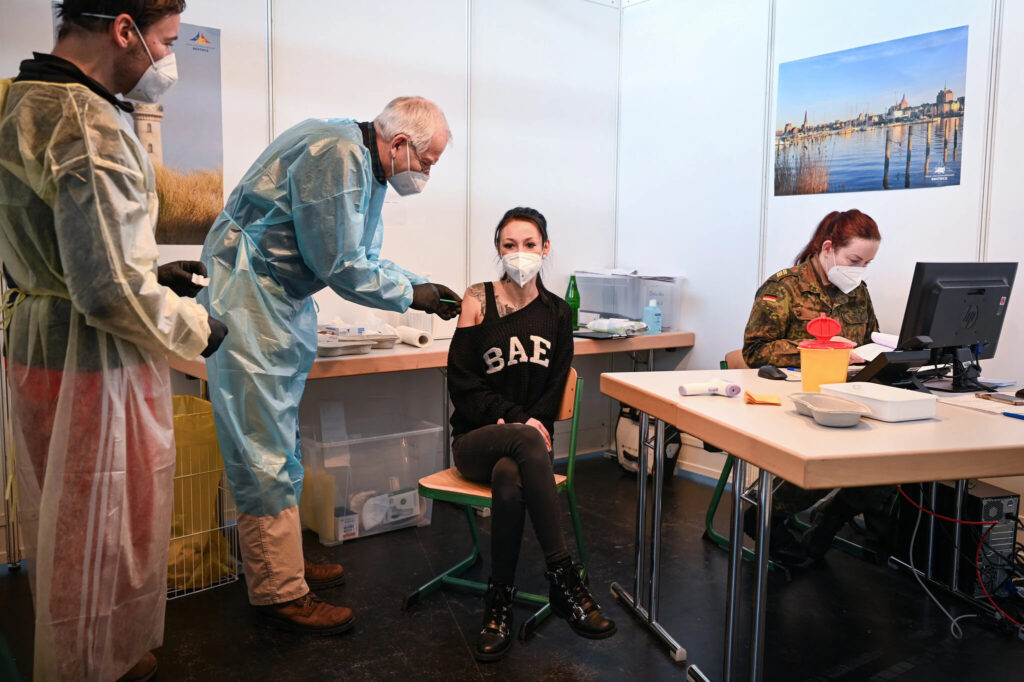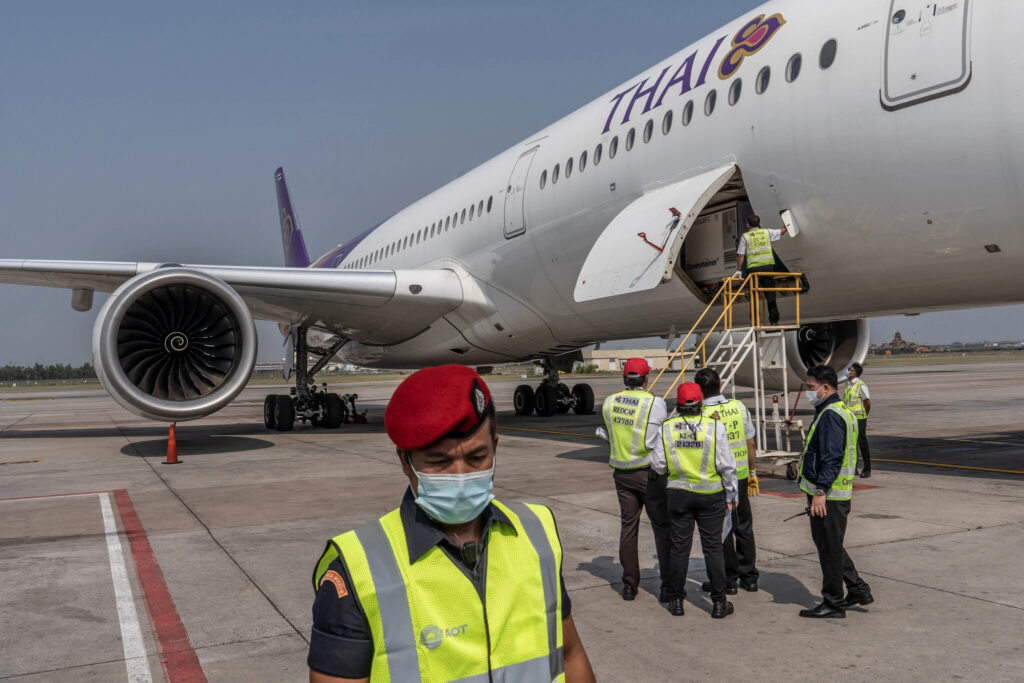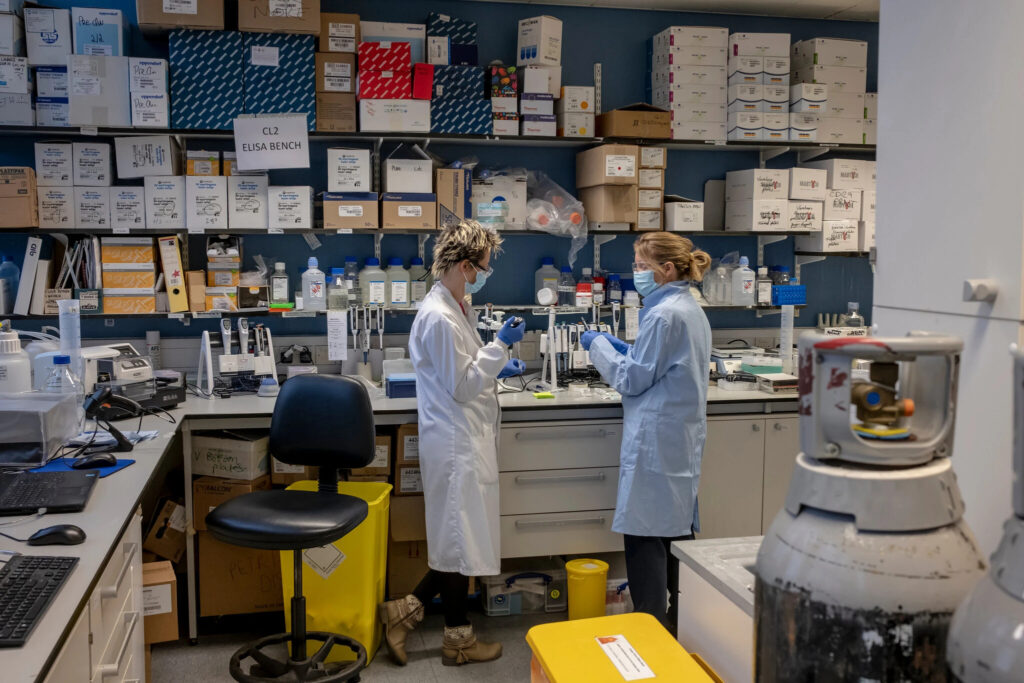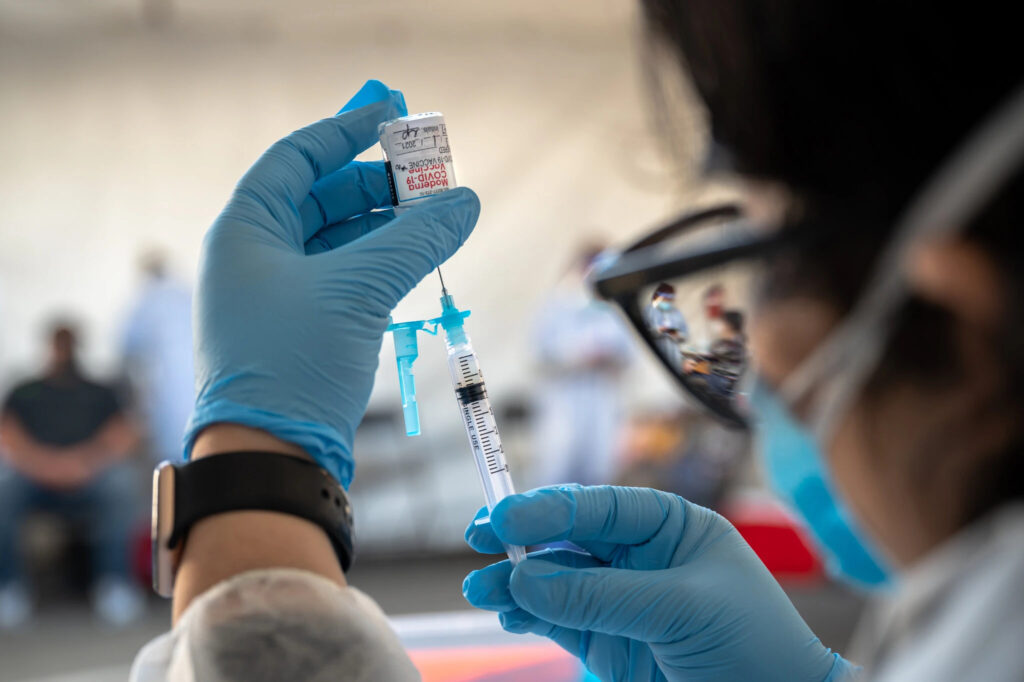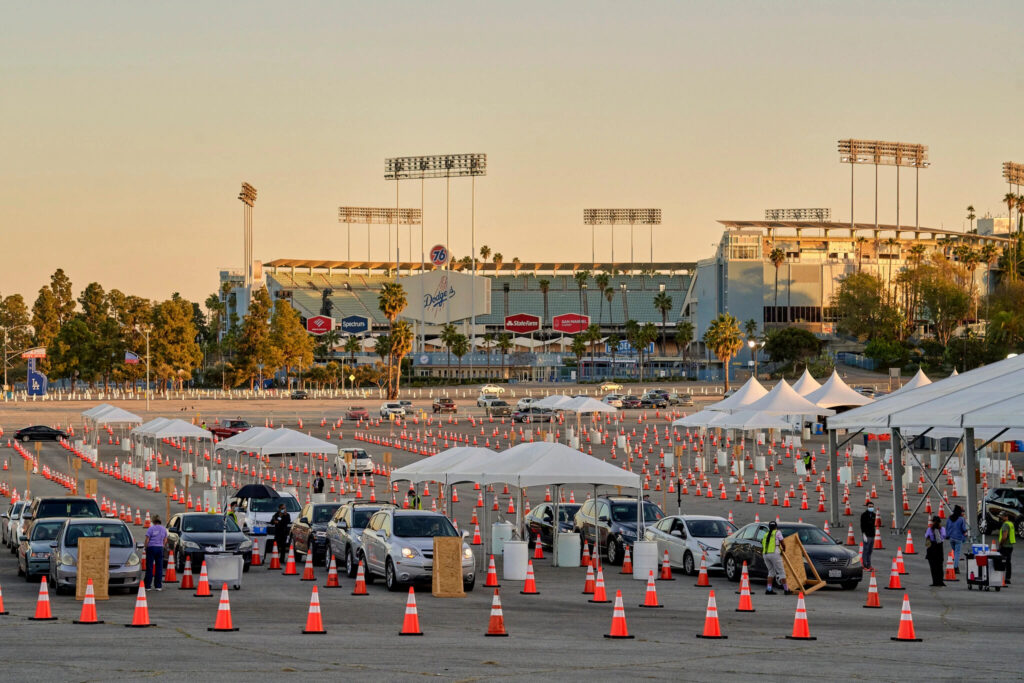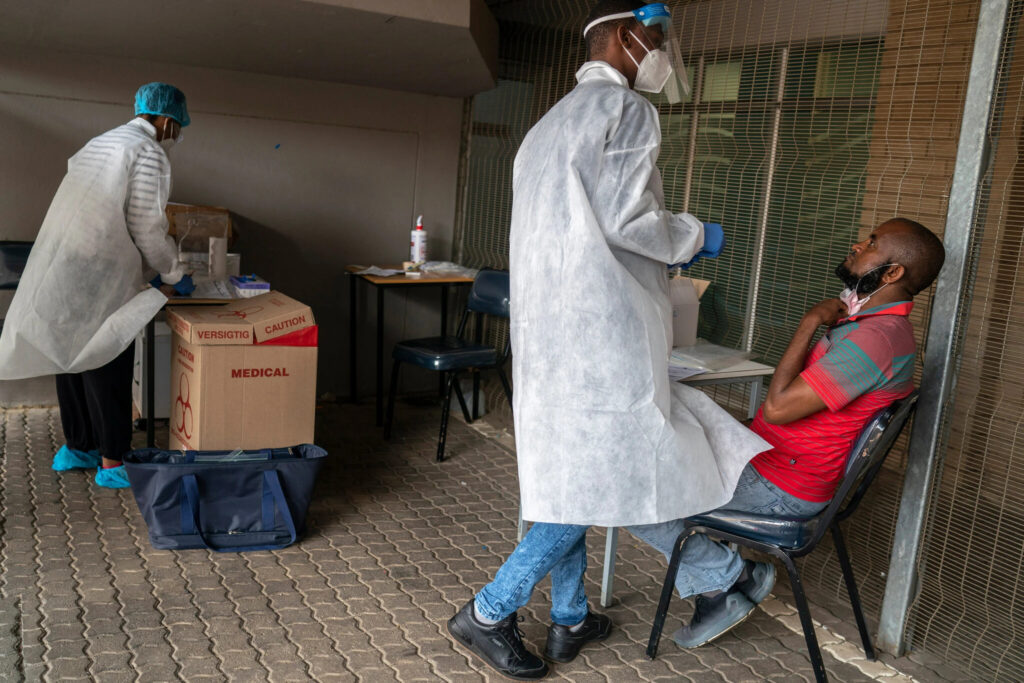Rich Countries Signed Away a Chance to Vaccinate the World
COVID19 - CORONAVIRUS, 22 Mar 2021
Selam Gebrekidan and Matt Apuzzo | The New York Times - TRANSCEND Media Service
Despite warnings, American and European officials gave up leverage that could have guaranteed access for billions of people. That risks prolonging the pandemic.
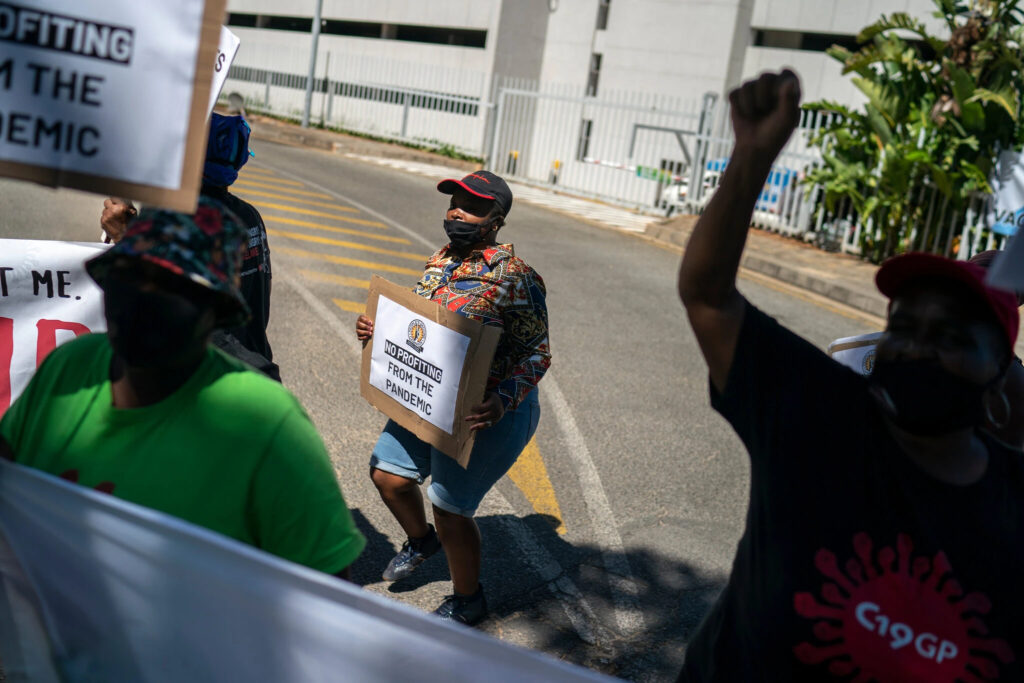
A protest in Johannesburg last week demanding that companies share vaccine technology and calling for governments to suspend Covid-19 vaccine patent rules. Joao Silva/The New York Times
21 Mar 2021 – In the coming days, a patent will finally be issued on a five-year-old invention, a feat of molecular engineering that is at the heart of at least five major Covid-19 vaccines. And the United States government will control that patent.
The new patent presents an opportunity — and some argue the last best chance — to exact leverage over the drug companies producing the vaccines and pressure them to expand access to less affluent countries.
The question is whether the government will do anything at all.
The rapid development of Covid-19 vaccines, achieved at record speed and financed by massive public funding in the United States, the European Union and Britain, represents a great triumph of the pandemic. Governments partnered with drugmakers, pouring in billions of dollars to procure raw materials, finance clinical trials and retrofit factories. Billions more were committed to buy the finished product.
But this Western success has created stark inequity. Residents of wealthy and middle-income countries have received about 90 percent of the nearly 400 million vaccines delivered so far. Under current projections, many of the rest will have to wait years.
Growing numbers of health officials and advocacy groups worldwide are calling for Western governments to use aggressive powers — most of them rarely or never used before — to force companies to publish vaccine recipes, share their know-how and ramp up manufacturing. Public health advocates have pleaded for help, including asking the Biden administration to use its patent to push for broader vaccine access.
Governments have resisted. By partnering with drug companies, Western leaders bought their way to the front of the line. But they also ignored years of warnings — and explicit calls from the World Health Organization — to include contract language that would have guaranteed doses for poor countries or encouraged companies to share their knowledge and the patents they control.
“It was like a run on toilet paper. Everybody was like, ‘Get out of my way. I’m gonna get that last package of Charmin,’” said Gregg Gonsalves, a Yale epidemiologist. “We just ran for the doses.”
The prospect of billions of people waiting years to be vaccinated poses a health threat to even the richest countries. One example: In Britain, where the vaccine rollout has been strong, health officials are tracking a virus variant that emerged in South Africa, where vaccine coverage is weak. That variant may be able to blunt the effect of vaccines, meaning even vaccinated people might get sick.
Western health officials said they never intended to exclude others. But with their own countries facing massive death tolls, the focus was at home. Patent sharing, they said, simply never came up.
“It was U.S.-centric. It wasn’t anti-global.” said Moncef Slaoui, who was the chief scientific adviser for Operation Warp Speed, a Trump administration program that funded the search for vaccines in the United States. “Everybody was in agreement that vaccine doses, once the U.S. is served, will go elsewhere.”
President Biden and Ursula von der Leyen, the president of the European Union’s executive branch, are reluctant to change course. Mr. Biden has promised to help an Indian company produce about 1 billion doses by the end of 2022 and his administration has donated doses to Mexico and Canada. But he has made it clear that his focus is at home.
“We’re going to start off making sure Americans are taken care of first,” Mr. Biden said recently. “But we’re then going to try and help the rest of the world.”
Pressuring companies to share patents could be seen as undermining innovation, sabotaging drugmakers or picking drawn-out and expensive fights with the very companies digging a way out of the pandemic.
As rich countries fight to keep things as they are, others like South Africa and India have taken the battle to the World Trade Organization, seeking a waiver on patent restrictions for Covid-19 vaccines.
Russia and China, meanwhile, have promised to fill the void as part of their vaccine diplomacy. The Gamaleya Institute in Moscow, for example, has entered into partnerships with producers from Kazakhstan to South Korea, according to data from Airfinity, a science analytics company, and UNICEF. Chinese vaccine makers have reached similar deals in the United Arab Emirates, Brazil and Indonesia.
Addressing patents would not, by itself, solve the vaccine imbalance. Retrofitting or constructing factories would take time. More raw materials would need to be manufactured. Regulators would have to approve new assembly lines.
And as with cooking a complicated dish, giving someone a list of ingredients is no substitute to showing them how to make it.
To address these problems, the World Health Organization created a technology pool last year to encourage companies to share know-how with manufacturers in lower-income nations.
Not a single vaccine company has signed up.
“The problem is that the companies don’t want to do it. And the government is just not very tough with the companies,” said James Love, who leads Knowledge Ecology International, a nonprofit.
Drug company executives told European lawmakers recently that they were licensing their vaccines as quickly as possible, but that finding partners with the right technology was challenging.
“They don’t have the equipment,” Moderna’s chief executive, Stéphane Bancel, said. “There is no capacity.”
But manufacturers from Canada to Bangladesh say they can make vaccines — they just lack patent licensing deals. When the price is right, companies have shared secrets with new manufacturers in just months, ramping up production and retrofitting factories.
It helps when the government sweetens the deal. Earlier this month, Mr. Biden announced that the pharmaceutical giant Merck would help make vaccines for its competitor Johnson & Johnson. The government pressured Johnson & Johnson to accept the help and is using wartime procurement powers to secure supplies for the company. It will also pay to retrofit Merck’s production line, with an eye toward making vaccines available to every adult in the United States by May.
Despite the hefty government funding, drug companies control nearly all of the intellectual property and stand to make fortunes off the vaccines. A critical exception is the patent expected to be approved soon — a government-led discovery for manipulating a key coronavirus protein.
This breakthrough, at the center of the 2020 race for a vaccine, actually came years earlier in a National Institutes of Health lab, where an American scientist named Dr. Barney Graham was in pursuit of a medical moonshot.
‘We’d already done everything’
For years, Dr. Graham specialized in the kind of long, expensive research that only governments bankroll. He searched for a key to unlock universal vaccines — genetic blueprints to be used against any of the roughly two dozen viral families that infect humans. When a new virus emerged, scientists could simply tweak the code and quickly make a vaccine.
In 2016, while working on Middle East Respiratory Syndrome, another coronavirus known as MERS, he and his colleagues developed a way to swap a pair of amino acids in the coronavirus spike protein. That bit of molecular engineering, they realized, could be used to develop effective vaccines against any coronavirus. The government, along with its partners at Dartmouth College and the Scripps Research Institute, filed for a patent, which will be issued this month.
When Chinese scientists published the genetic code of the new coronavirus in January 2020, Dr. Graham’s team had their cookbook ready.
“We kind of knew exactly what we had to do,” said Jason McLellan, one of the inventors, who now works at the University of Texas at Austin. “We’d already done everything.”
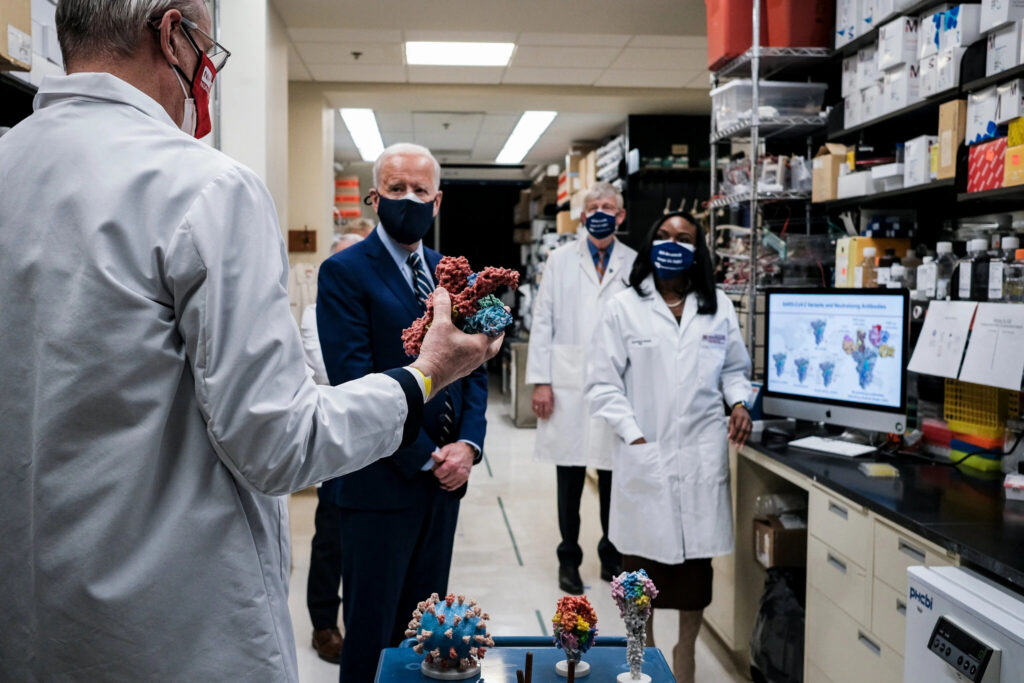
Dr. Barney Graham, left, and his deputy, Dr. Kizzmekia Corbett, right, explaining the role of spike proteins to President Biden at the National Institutes of Health in Bethesda, Md., last month.
Pete Marovich for The New York Times
Dr. Graham was already working with Moderna on a vaccine for another virus when the outbreak in China inspired his team to change focus. “We just flipped it to coronavirus and said, ‘How fast can we go?’” Dr. Graham recalled.
Within a few days, they emailed the vaccine’s genetic blueprint to Moderna to begin manufacturing. By late February, Moderna had produced enough vaccines for government-run clinical trials.
“We did the front end. They did the middle. And we did the back end,” Dr. Graham said.
Exactly who holds patents for which vaccines won’t be sorted out for months or years. But it is clear now that several of today’s vaccines — including those from Moderna, Johnson & Johnson, Novavax, CureVac and Pfizer-BioNTech — rely on the 2016 invention. Of those, only BioNTech has paid the U.S. government to license the technology. The patent is scheduled to be issued March 30.
Patent lawyers and public health advocates say it’s likely that other companies will either have to negotiate a licensing agreement with the government, or face the prospect of a lawsuit worth billions. The government filed such a lawsuit in 2019 against the drugmaker Gilead over H.I.V. medication.
This gives the Biden administration leverage to force companies to share technology and expand worldwide production, said Christopher J. Morten, a New York University law professor specializing in medical patents.
“We can do this the hard way, where we sue you for patent infringement,” he said the government could assert. “Or just play nice with us and license your tech.”
The National Institutes of Health declined to comment on its discussions with the drugmakers but said it did not anticipate a dispute over patent infringement. None of the drug companies responded to repeated questions about the 2016 patent.
Experts said the government has stronger leverage on the Moderna vaccine, which was almost entirely funded by taxpayers. New mRNA vaccines, such as those from Moderna, are relatively easier to manufacture than vaccines that rely on live viruses. Scientists compare it to an old-fashioned cassette player: Try one tape. If it’s not right, just pop in another.
Moderna expects $18.4 billion in vaccine sales this year, but it is the delivery system — the cassette player — that is its most prized secret. Disclosing it could mean giving away the key to the company’s future.
By last spring, with the Moderna vaccine in its earliest trials, vaccine science had clearly become a nationalistic competition. World leaders joined the W.H.O. in April to raise $8 billion for Covid-19 vaccines, tests and treatments, but China and the United States were notably absent.
“There should be no division in order to win this battle,” President Emmanuel Macron of France said.
Yet European governments had backed their own champions. The European Investment Bank lent nearly $120 million to BioNTech, a German company, and Germany bought a $360 million stake in the biotech firm CureVac after reports that it was being lured to the United States.
“We funded the research, on both sides of the Atlantic,” said Udo Bullmann, a German member of the European Parliament. “You could have agreed on a paragraph that says ‘You are obliged to give it to poor countries in a way that they can afford it.’ Of course you could have.”
A People’s Vaccine
In May, the leaders of Pakistan, Ghana, South Africa and others called for governments to support a “people’s vaccine” that could be quickly manufactured and given for free.
They urged the governing body of the World Health Organization to treat vaccines as “global public goods.”
Though such a declaration would have had no teeth, the Trump administration moved swiftly to block it. Intent on protecting intellectual property, the government said calls for equitable access to vaccines and treatments sent “the wrong message to innovators.”
World leaders ultimately approved a watered-down declaration that recognized extensive immunization — not the vaccines themselves — as a global public good.
That same month, the World Health Organization launched the technology-access pool and called on governments to include clauses in their drug contracts guaranteeing equitable distribution. But the world’s richest nations roundly ignored the call.
In the United States, Operation Warp Speed went on a summertime spending spree, disbursing over $10 billion to handpicked companies and absorbing the financial risks of bringing a vaccine to market.
“Our role was to enable the private sector to be successful,” said Paul Mango, a top adviser to the then health secretary, Alex M. Azar II.
The deals came with few strings attached.
Large chunks of the contracts are redacted and some remain secret. But public records show that the government used unusual contracts that omitted its right to take over intellectual property or influence the price and availability of vaccines. They did not let the government compel companies to share their technology.
British and other European leaders made similar concessions as they ordered enough doses to vaccinate their populations multiple times over.
“You have to write the rules of the game, and the place to do that would have been these funding contracts,” said Ellen ’t Hoen, the director of Medicines Law and Policy, an international research group.
By comparison, one of the world’s largest health financiers, the Bill & Melinda Gates Foundation, includes grant language requiring equitable access to vaccines. As leverage, the organization retains some right to the intellectual property.
Dr. Slaoui, who came to Warp Speed after leading research and development at GlaxoSmithKline, is sympathetic to this idea. But it would have been impractical to demand patent concessions and still deliver on the program’s primary goals of speed and volume, he said.
“I can guarantee you that the agreements with the companies would have been much more complex and taken a much longer time,” he said. The European Union, for example, haggled over price and liability provisions, which delayed the rollout.
In some ways, this was a trip down a trodden path. When the H1N1 “swine flu” pandemic broke out in 2009, the wealthiest countries cornered the global vaccine market and all but locked out the rest of the world.
Experts said at the time that this was a chance to rethink the approach. But the swine flu pandemic fizzled and governments ended up destroying the vaccines they had hoarded. They then forgot to prepare for the future.
The International View
For months, the United States and European Union have blocked a proposal at the World Trade Organization that would waive intellectual property rights for Covid-19 vaccines and treatments. The application, put forward by South Africa and India with support from most developing nations, has been bogged down in procedural hearings.
“Every minute we are deadlocked in the negotiating room, people are dying,” said Mustaqeem De Gama, a South African diplomat who is involved in the talks.
But in Brussels and Washington, leaders are still worried about undermining innovation.
During the presidential campaign, Mr. Biden’s team gathered top intellectual property lawyers to discuss ways to increase vaccine production.
“They were planning on taking the international view on things,” said Ana Santos Rutschman, a Saint Louis University law professor who participated in the sessions.
Most of the options were politically thorny. Among them was the use of a federal law allowing the government to seize a company’s patent and give it to another in order to increase supply. Former campaign advisers say the Biden camp was lukewarm to this proposal and others that called for a broader exercise of its powers.
The administration has instead promised to give $4 billion to Covax, the global vaccine alliance. The European Union has given nearly $1 billion so far. But Covax aims to vaccinate only 20 percent of people in the world’s poorest countries this year, and faces a $2 billion shortfall even to accomplish that.
Dr. Graham, the N.I.H. scientist whose team cracked the coronavirus vaccine code for Moderna, said that pandemic preparedness and vaccine development should be international collaborations, not competitions.
“A lot of this would not have happened unless there was a big infusion of government money,” he said.
But governments cannot afford to sabotage companies that need profit to survive.
Dr. Graham has largely moved on from studying the coronavirus. He is searching for a universal flu vaccine, a silver bullet that could prevent all strains of the disease without an annual tweak.
Though he was vaccinated through work, he spent the early part of the year trying to get his wife and grown children onto waiting lists — an ordeal that even one of the key inventors had to endure. “You can imagine how aggravating that is,” he said.
________________________________________________
 Matt Apuzzo is a two-time Pulitzer Prize-winning reporter based in Brussels. He has covered law enforcement and security matters for more than a decade and is the co-author of the book “Enemies Within.” @mattapuzzo
Matt Apuzzo is a two-time Pulitzer Prize-winning reporter based in Brussels. He has covered law enforcement and security matters for more than a decade and is the co-author of the book “Enemies Within.” @mattapuzzo
Matina Stevis-Gridneff and Monika Pronczuk contributed reporting.
Tags: AstraZeneca Vaccine, Big Pharma, COVID-19, Conflict, Coronavirus, Corruption, Elites, Medical Industrial Complex, Vaccine Apartheid, Vaccines
DISCLAIMER: The statements, views and opinions expressed in pieces republished here are solely those of the authors and do not necessarily represent those of TMS. In accordance with title 17 U.S.C. section 107, this material is distributed without profit to those who have expressed a prior interest in receiving the included information for research and educational purposes. TMS has no affiliation whatsoever with the originator of this article nor is TMS endorsed or sponsored by the originator. “GO TO ORIGINAL” links are provided as a convenience to our readers and allow for verification of authenticity. However, as originating pages are often updated by their originating host sites, the versions posted may not match the versions our readers view when clicking the “GO TO ORIGINAL” links. This site contains copyrighted material the use of which has not always been specifically authorized by the copyright owner. We are making such material available in our efforts to advance understanding of environmental, political, human rights, economic, democracy, scientific, and social justice issues, etc. We believe this constitutes a ‘fair use’ of any such copyrighted material as provided for in section 107 of the US Copyright Law. In accordance with Title 17 U.S.C. Section 107, the material on this site is distributed without profit to those who have expressed a prior interest in receiving the included information for research and educational purposes. For more information go to: http://www.law.cornell.edu/uscode/17/107.shtml. If you wish to use copyrighted material from this site for purposes of your own that go beyond ‘fair use’, you must obtain permission from the copyright owner.
Read more
Click here to go to the current weekly digest or pick another article:
COVID19 - CORONAVIRUS:
